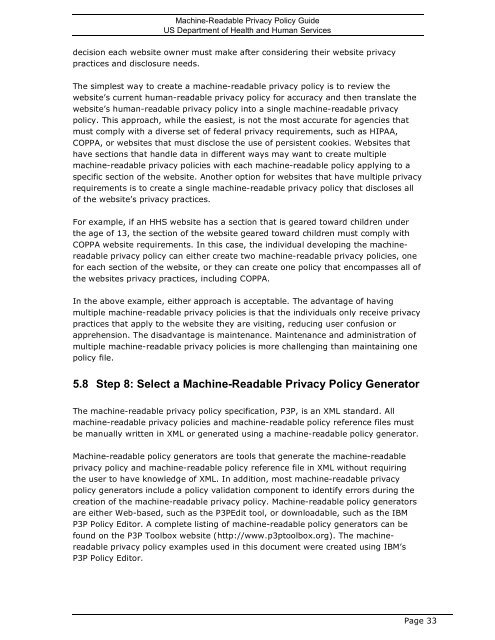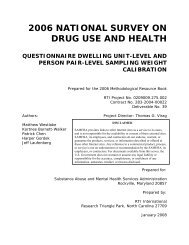HHS Machine-Readable Privacy Policy Guide - Substance Abuse ...
HHS Machine-Readable Privacy Policy Guide - Substance Abuse ...
HHS Machine-Readable Privacy Policy Guide - Substance Abuse ...
Create successful ePaper yourself
Turn your PDF publications into a flip-book with our unique Google optimized e-Paper software.
<strong>Machine</strong>-<strong>Readable</strong> <strong>Privacy</strong> <strong>Policy</strong> <strong>Guide</strong><br />
US Department of Health and Human Services<br />
decision each website owner must make after considering their website privacy<br />
practices and disclosure needs.<br />
The simplest way to create a machine-readable privacy policy is to review the<br />
website’s current human-readable privacy policy for accuracy and then translate the<br />
website’s human-readable privacy policy into a single machine-readable privacy<br />
policy. This approach, while the easiest, is not the most accurate for agencies that<br />
must comply with a diverse set of federal privacy requirements, such as HIPAA,<br />
COPPA, or websites that must disclose the use of persistent cookies. Websites that<br />
have sections that handle data in different ways may want to create multiple<br />
machine-readable privacy policies with each machine-readable policy applying to a<br />
specific section of the website. Another option for websites that have multiple privacy<br />
requirements is to create a single machine-readable privacy policy that discloses all<br />
of the website’s privacy practices.<br />
For example, if an <strong>HHS</strong> website has a section that is geared toward children under<br />
the age of 13, the section of the website geared toward children must comply with<br />
COPPA website requirements. In this case, the individual developing the machinereadable<br />
privacy policy can either create two machine-readable privacy policies, one<br />
for each section of the website, or they can create one policy that encompasses all of<br />
the websites privacy practices, including COPPA.<br />
In the above example, either approach is acceptable. The advantage of having<br />
multiple machine-readable privacy policies is that the individuals only receive privacy<br />
practices that apply to the website they are visiting, reducing user confusion or<br />
apprehension. The disadvantage is maintenance. Maintenance and administration of<br />
multiple machine-readable privacy policies is more challenging than maintaining one<br />
policy file.<br />
5.8 Step 8: Select a <strong>Machine</strong>-<strong>Readable</strong> <strong>Privacy</strong> <strong>Policy</strong> Generator<br />
The machine-readable privacy policy specification, P3P, is an XML standard. All<br />
machine-readable privacy policies and machine-readable policy reference files must<br />
be manually written in XML or generated using a machine-readable policy generator.<br />
<strong>Machine</strong>-readable policy generators are tools that generate the machine-readable<br />
privacy policy and machine-readable policy reference file in XML without requiring<br />
the user to have knowledge of XML. In addition, most machine-readable privacy<br />
policy generators include a policy validation component to identify errors during the<br />
creation of the machine-readable privacy policy. <strong>Machine</strong>-readable policy generators<br />
are either Web-based, such as the P3PEdit tool, or downloadable, such as the IBM<br />
P3P <strong>Policy</strong> Editor. A complete listing of machine-readable policy generators can be<br />
found on the P3P Toolbox website (http://www.p3ptoolbox.org). The machinereadable<br />
privacy policy examples used in this document were created using IBM’s<br />
P3P <strong>Policy</strong> Editor.<br />
Page 33
















